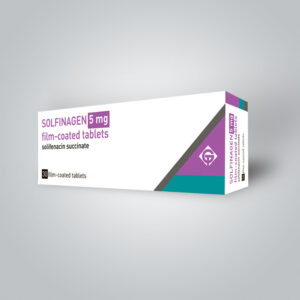 SOLFINAGEN coated tablets
SOLFINAGEN coated tablets
SOLFINAGEN
International non-patented name: Solifenacin succinate
Composition
Active substance: 1 tablet contains 5 mg of solifenacin succinate (equivalent to 3.8 mg of solifenacin).
Excipients: corn starch, lactose monohydrate, hypromellose (2910 5mPa.s), magnesium stearate
Coating: hypromellose (2910), talc, titanium dioxide (E171), macrogol, yellow iron oxide (E172).
Description
Round shaped, biconvex, light yellow coated tablets.
Farmakoterapevtik qrupu
Medicines used for urinary incontinence and urinary frequency.
ATC: G04BD08.
Pharmacological properties
Pharmacodynamics
Solfinagen is a competitive specific blocker of muscarinic cholinergic receptors, mainly of the M3 subtype.
Pharmacokinetics
Being asked
After oral administration of Solfinagen tablets, the maximum plasma concentration (Cmax) occurred 3-8 hours later. Tmax is independent of dose. Absolute bioavailability is about 90%. Food intake does not affect Solfinagen Cmax and AUC.
Distribution
The degree of binding to plasma proteins (mainly α1-acid glycoprotein) is high (about 98%).
Biotransformation
Solfinagen undergoes active metabolism in the liver, mainly through the CYP3A4 isoenzyme of cytochrome P450. System clearance is 9.5 l/hour, and the terminal elimination half-life is 45-68 hours.
Exclusion
26 days after administration of 10 mg single dose of 14C-labeled solifenacin, 70% of its radioactivity is determined in urine and 23% in feces. About 11% of its radioactivity is determined in the urine as unchanged, about 18% as N-oxide metabolite, 9% as 4R-hydroxy N-oxide metabolite and 8% as 4R-hydroxymetabolite (active metabolite).
Indication for use
Symptomatic treatment of urgent (imperative) urinary retention and/or frequent urination and urgent (imperative) urge to urinate, characteristic of patients with overactive bladder syndrome.
Contraindications
Hypersensitivity to Solfinagen or other components of the drug.
Urinary retention, severe gastrointestinal diseases (including toxic megacolon), myasthenia gravis (myasthenia gravis), angle-closure glaucoma and people prone to these diseases.
Patients undergoing hemodialysis.
Severe liver failure.
Treatment with CYP3A4 inhibitors (eg, ketoconazole) in the setting of severe renal failure or moderate liver failure.
Special instructions and precautions
Solfinagen may increase the likelihood of QT prolongation and torsade de pointes when used together with drugs. For this reason, Solfinagen should not be used in combination with the indicated drugs.
Before prescribing Solfinagen, other causes of increased frequency of urination (heart failure or kidney disease) should be determined. In case of urinary tract infection, appropriate antibacterial treatment should be started.
The drug should be used with caution in the following cases:
– clinically significant obstruction of the bladder opening, which is the reason for the possibility of urinary retention;
– obstructive diseases of the gastrointestinal tract;
– the possibility of weakening the motor activity of the gastrointestinal tract;
– severe renal insufficiency (creatinine clearance less than 30 ml/min) – the dose in such patients should not exceed 5 mg;
– moderate liver failure (7-9 points according to the Child-Pugh scale; the dose in such patients should not exceed 5 mg);
– combined use with inhibitors of CYP3A4 (eg, ketoconazole);
– patients receiving medications (such as bisphosphonates) that may cause or exacerbate diaphragmatic hernia/gastroesophageal reflux and/or esophagitis;
– autonomic neuropathy.
The safety and efficacy of the drug in patients with neurogenic detrusor hyperactivity have not been studied.
This drug should not be used in patients with rare hereditary diseases such as galactose intolerance, Lapp lactase deficiency or glucose-galactose malabsorption syndrome.
Each dose contains less than 1 mmol sodium; no additional effects are expected with that amount of sodium.
The maximum effect of the drug Solfinagen can be observed after at least 4 weeks.
Interaction with other drugs
Pharmacological interactions
Combined use with other anticholinergic drugs can result in strengthening of the therapeutic effect and side effects. Treatment with other anticholinergic agents should be started after an interval of approximately one week after stopping the use of Solfinagen. The therapeutic effect of Solfinagen can be reduced when it is used together with agonists of cholinergic receptors.
Solfinagen may reduce the effect of drugs that stimulate gastrointestinal motility, such as metoclopramide and cisapride.
Effect of other drugs on the pharmacokinetics of solifenacin
Solfinagen is metabolized by CYP3A4. For this reason, when used together with ketoconazole – more than a dose of 5 mg, when used together with other strong inhibitors of CYP3A4 (eg, ritonavir, nelfinavir, itraconazole) – it should not be prescribed more than a therapeutic dose.
Solfinagen is likely to interact with verapamil, diltiazem, rifampicin, phenytoin, carbamazepine.
Effects of solifenacin on the pharmacokinetics of other drugs
Oral contraceptives: Solfinagen does not affect combined oral contraceptives (ethinyl estradiol/levonorgestrel).
Warfarin: Solfinagen administration did not alter the pharmacokinetics or prothrombin time of R-warfarin or S-warfarin.
Digoxin: Solfinagen does not affect the pharmacokinetics of digoxin.
Use during pregnancy and lactation
There is no data on pregnant women while taking Solfinagen. Solfinagen should be prescribed with caution during pregnancy.
Information on the transfer of Solfinagen to breast milk is not available. The use of the drug should be avoided during lactation.
Effects on the ability to drive vehicles and other potentially dangerous mechanisms
As with other anticholinergic drugs, solifenacin may cause blurred vision and sometimes drowsiness and fatigue, which may affect the ability to drive vehicles and operate machinery.
Method of use and dosage
Adults, including the elderly
The recommended dose is 5 mg once a day. If necessary, the dose can be increased to 10 mg once a day.
Solfinagen drug can be used for a long time. Tablets should be taken inside, whole, regardless of food intake, 1 time a day with water.
Additional information on special groups of patients
Patients with renal failure
In case of mild and moderate renal insufficiency (creatinine clearance more than 30 ml/min) there is no need to adjust the dose. In case of severe renal insufficiency (creatinine clearance less than 30 ml/min), the drug should be prescribed with caution and should not be taken more than 5 mg once a day.
Patients with liver failure
There is no need to adjust the dose in case of mild hepatic insufficiency. In case of moderate liver failure (7-9 points according to the Child-Pugh scale), the drug should be prescribed with caution and should not be taken more than 5 mg once a day.
Pediatric patients
The safety and effectiveness of the drug have not been studied in children. For this reason, Solfinagen should not be used in children.
Elderly patients
The recommended dose is 5 mg once a day. If necessary, the dose can be increased to 10 mg once a day.
Other
Strong inhibitors of cytochrome P450 3A4: Solfinagen should not be prescribed more than 5 mg when used with ketoconazole or when used with other CYP3A4 inhibitors such as ritonavir, nelfinavir, itraconazole – more than the therapeutic dose.
Side effects
Solfinagen may cause mild to moderate anticholinergic side effects. The frequency of these reactions depends on the dose. Although dry mouth is the most common side effect, it is mild and rarely leads to treatment discontinuation.
Frequency of side effects: very often (≥1/10); often (≥1/100 to <1/10); sometimes (≥1/1000 to <1/100); rare (≥1/10,000 to <1/1,000); very rare (<1/10000); with an unknown frequency (the available data are insufficient to determine the frequency of occurrence).
Infections and infestations
sometimes: urinary tract infections, cystitis.
Immune system disorders
frequency unknown: anaphylactic reaction.
Mental disorders
very rare: hallucinations, confusion.
frequency unknown: delirium.
To the nervous system sometimes: drowsiness, dysgeusia;
very rare: dizziness, headache.
To the organ of vision often: blurred vision;bəzən: gözün quruluğu;
frequency not known: glaucoma.
To the respiratory system, chest and inter-mural organs
sometimes: dryness in the nasal cavity;
frequency unknown: dysphonia.
To the digestive system
very often: dry mouth;
often: constipation, nausea, dyspepsia, abdominal pain;
sometimes: gastroesophageal reflux disease, dry throat;
rare: intestinal obstruction.
very rare: vomiting;
Frequency not known: abdominal discomfort.
To the skin and subcutaneous adipose tissue
sometimes: dry skin;
very rarely: itching, rash, urticaria, angioedema, erythema multiforme.
frequency unknown: exfoliative dermatitis.
To the musculoskeletal system
Frequency not known: muscle weakness.
To the kidneys and urinary tract
sometimes: difficulty during urination;
rarely: urinary retention.
frequency is unknown: kidney disorders
General disorders and local reactions
sometimes: fatigue, peripheral edema.
Reporting of suspected adverse reactions
It is important to inform the doctor about suspected side effects after the registration of the drug. Such information allows for continued monitoring of the benefit/risk ratio of the drug.
Consult a doctor if unwanted effects occur.
Overdose
Solfinagen overdose can cause severe anticholinergic effects. In case of overdose, it is necessary to use activated charcoal and wash the stomach. The patient should not be induced to vomit.
If necessary, the following symptomatic treatment is carried out:
physostigmine or carbachol is prescribed in case of severe centrally acting anticholinergic effects (hallucinations or significant wakefulness);
benzodiazepines are prescribed during seizures or significant wakefulness;
artificial respiration is given in case of respiratory failure;
in case of tachycardia, β-blockers are prescribed;
catheterization is performed during urinary retention;
in case of mydriasis, pilocarpine eye drops are prescribed and/or the patient is placed in a dark room.
As with the overdose of other m-cholinoblockers, special attention should be paid to patients with the possibility of QT prolongation (hypokalemia, bradycardia and concomitant use with drugs that prolong the QT interval) and heart diseases (myocardial ischemia, arrhythmia, chronic heart failure)
Packing form
5 mg tablets
10 tablets in blister. 3 blisters, leaflet in cardon packing.
Store condition
-It should be stored at a temperature not higher than 25°C, in its own box, in a dark place and out of the reach of children
Shelf life
2 il.
By precsription.
Manufacturer
ATLANTIC PHARMA S.A., Portugal.
Rua da Tapada Grande, n.º 2, Abrunheira, 2710-089 Sintra, Portugal
